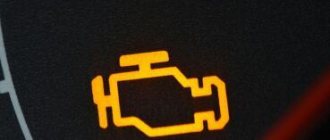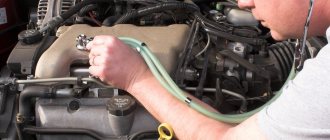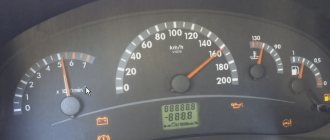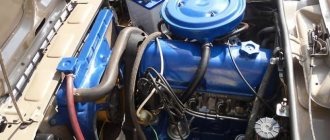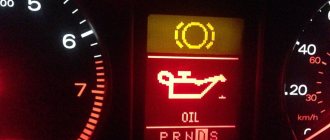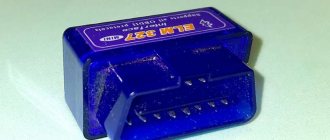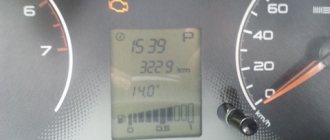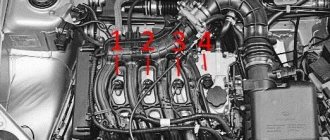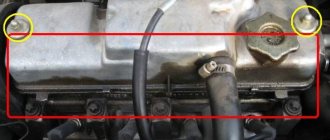Many of us have probably encountered such a problem as turning on the engine icon (“Check engine…”), the appearance of which on the car dashboard scares drivers. Today we invite you to familiarize yourself with the 5 (five) most common reasons why the check engine light comes on on the dashboard.
The appearance of the engine indicator icon on the dashboard usually occurs without warning. The reason for the appearance of this “Check Engine” cannot be immediately understood. Even if the car has auto diagnostics (for example, in cars such as BMW, Audi, Porshe, Mercedes-Benz, VW), which scans all car systems for errors and their presence, displaying decryption information on the instrument panel, such reasons for the appearance The engine checks will not be deciphered.
For most drivers, the appearance of this warning icon on the instrument panel means the need to urgently go to a car repair shop for diagnosis and to eliminate the reason why the “Check Engine” warning icon appeared. But in fact, in most cases, when the “Check” indication appears, you can independently diagnose the cause of the engine failure, and in some cases it is even possible to eliminate this cause yourself without a trip to a car service center, which will certainly save you money.
Replace the oxygen sensor (lambda probe)
The oxygen sensor in your car is part of the exhaust system that monitors how much oxygen is not burned in the engine combustion chamber. This sensor helps control the vehicle's fuel consumption. A malfunction of the oxygen sensor (lambda probe) means that the car computer does not receive the correct data and can significantly increase fuel consumption, and at the same time reduce engine power. Most cars have 2 to 4 oxygen sensors. If you have a home car error scanner, then by connecting it to the car you can easily find out which sensor needs to be replaced.
For what reason does the oxygen sensor in a car become unusable: - Over time, the sensor becomes covered with a layer of used and regular motor oil (oil soot), which reduces the accuracy of reading sensor readings for regulating the gasoline mixture and distributing optimal fuel consumption. A malfunction of the oxygen sensor in a car leads not only to increased fuel consumption, but also to an increased content of harmful CO2 substances in the exhaust.
What needs to be done: -If you do not change a faulty car oxygen sensor, this may lead to failure of the car catalyst (it may burst), which will result in expensive repairs for you. The cost of new catalysts is very high due to the precious alloys they contain. Some cars have several of these catalysts at once and their cost can reach up to 90 thousand rubles. So gentlemen, don’t delay replacing the oxygen sensor. Although replacing the sensor itself and its cost are decent, it is still not commensurate with the cost of the exhaust gas catalyst system itself. You can save money on replacing this sensor by doing it yourself. Many car manuals have detailed instructions on how to replace the oxygen sensor yourself. If you know where the oxygen sensor is located, then it will not be difficult for you to disconnect the faulty lambda probe and replace it with a new one. Remember that you cannot delay replacing this important element!
What else do you need to think about?
We were able to describe several of the most frequently repeated cases of this signal lighting up. The engine designs of different cars differ, so there may be other reasons for the appearance of an alarm signal. It will be best for you and your car if computer diagnostics of all car systems is carried out. To do this, you can use the services of specialized centers, but some “advanced” drivers do this on their own.
Pay more attention to your “iron horse”, use only high-quality fuel and consumables, then you won’t have to worry about why the check light comes on when driving. And if you do see an “alarming” signal, do not rush to extremes, but delve into the problem and eliminate it.
Check the fuel filler cap
Many drivers, in some cases, when the “check engine” indication appears, begin to think about serious problems with the engine; they do not even think of checking the tightness of the fuel system, which may be compromised due to a defect or an insufficiently tightened fuel tank cap. This is a very common reason for the appearance of the “Check” engine icon.
Reason for the error: - Leakage of the fuel system due to the passage of air through the filler cap of the fuel tank, as well as an increase in the fuel consumption of the vehicle, for which the vehicle’s diagnostic system will definitely display an engine error by turning on the “Check engine” indication on the vehicle’s instrument panel.
What needs to be done: -If when the “Check” indication appears, your car has not lost its power and there are no audible signs of engine damage (knocking, humming, creaking, etc. in the engine), then the first thing you need to do is check the gas tank for leaks. Your gas cap may be cracked or not tightened enough. If the gas tank cap was not tightened enough, then after tightening it all the way, you can continue driving the car for a while, and then look at the dashboard and see if the engine error disappears. To prevent the check engine light from appearing and lighting up, check the fuel filler cap regularly. Remember also that periodically this cover must be replaced with a new one!
What does it mean
Check Engine is translated from English as “check the motor (engine).” The error code is indicated as follows: P0102… P0616.
The first letter of the error code identifies one of the car systems in which the breakdown occurred. There can be 4 codes in total:
- P - gearbox and/or engine;
- U - CAN bus;
- C - chassis;
- B - airbags, electric windows, central locking.
The second character after the letter indicates the type of error. The breakdown can be general (the same for all OBD II engines) or specific (for a specific car).
When the check icon appears
The second character of the error code is indicated by the following numbers:
- 0 - OBD 2 code;
- 1, 2 — manufacturer code;
- 3 - Reserved SAE (reserve).
The third character of the error code is the car subsystem where the failure occurred. The following numbers may appear on the receipt icon in your car:
- 1, 2 - injector circuit, fuel pump, fuel tank or air supply system;
- 3 - ignition system;
- 4 — auxiliary system (control);
- 5 — car speed, idle;
- 6 - ECU and its external circuits;
- 7, 8 — gearbox;
- 9, 10 - reserve.
The fourth and fifth characters of the error code indicate its serial number.
Car exhaust catalyst
An automobile catalytic converter helps the vehicle make this engine exhaust more environmentally friendly. It converts carbon monoxide and other harmful substances into harmless compounds. If your exhaust catalyst has become unusable, then you will notice it not only when the check engine icon appears, but also long before the moment when the power of your car drops by half. For example, when you press the gas pedal, your car will not have the same good acceleration dynamics as before.
What can cause a car catalyst to fail: -If you regularly service your car in accordance with the car company's maintenance regulations, then the catalyst in the car should not fail. The main reason for catalyst failure is untimely replacement of a faulty oxygen sensor, as well as irregular replacement of spark plugs after their expiration date. When the oxygen sensor or spark plugs are faulty, the conversion of carbon monoxide in the catalyst into harmless chemical elements stops, and this leads to overheating of the catalyst, which because of this can fail.
What needs to be done: -If your catalyst has become unusable, then you cannot drive a car, since the engine in the car will not work correctly, warning about this by an indication on the dashboard with the “check” engine icon. Also, your car's fuel consumption will greatly increase and there will be no engine traction. Although replacing the catalyst is an expensive repair, there is still no escape from this repair. Although today there is an alternative to replacing the catalyst with a flame arrester, this is not a 100% option. Unfortunately for many, if you are not an experienced auto mechanic, you will not be able to replace a faulty exhaust gas catalyst yourself. In any case, you will have to contact a car repair shop. Remember, friends, that timely replacement of oxygen sensors and spark plugs protects your catalyst from damage!
Table of the most common error codes
To find out the error code, you need to do the following:
- Turn off the car engine.
- Look under the steering wheel and find the diagnostic connector.
- Install the OBD 2 scanner into the found connector. If everything is done correctly, the indicator on the adapter will light up.
- Pick up your smartphone and open Google Play Store.
- Download, install and run the Torque program.
- Open “Settings” on your phone, select the Bluetooth tab and find the Aut-Tech scanner.
- In the window that appears, you must enter the password - 1234 (1111, 1234, 0000, 123456) and click on “OK”. The inscription “Authorized” will appear in the list.
- Launch the Torque program.
- On the smartphone screen, click on the button with a gear - this is “Settings” (or on the button on the phone body).
- In the menu that appears, select “Settings”. In it you need to open the Connection section. Bluetooth (Wi-Fi) must be installed here.
- Select the Device section. In the list, click on the Aut-Tech scanner.
- Exit to the Torque program menu and click on Check Fault Codes. The error log will open.
- Click on the search button (in the form of a magnifying glass). An error code will be displayed on the screen.
An overview table of common error codes with explanations is presented below.
Error Code Table
Once the error code has been deciphered, you can safely begin troubleshooting the problem yourself. If serious damage is detected, you must take your car to a service station.
Replace the mass air flow sensor
The mass air flow sensor regulates the amount of air that must be added to the gasoline mixture for optimal combustion of the fuel. This sensor constantly reports data on the amount of oxygen supplied to the car's computer. A faulty mass air flow sensor increases this fuel consumption and also increases the level of CO2 in the exhaust gas, thereby reducing engine power and smoothness. Also, if the sensor is faulty, poor acceleration dynamics are observed. In cold weather, a car with a faulty sensor has difficulty starting.
What are the reasons for the failure of the mass air flow sensor: -Most failures of such sensors occur due to improper installation of the air filter during its scheduled replacement. Also, if you do not regularly change the air filter, as required by the vehicle maintenance regulations recommended by the automaker, the mass air flow sensor may fail.
What needs to be done: -Theoretically, you can, of course, drive for a long time with a broken mass air flow sensor (several weeks or months). But you yourself will soon notice that the longer you drive, the more fuel consumption increases. Replacing a sensor in a car service is not so expensive, since this work itself does not take much time and is quite simple. Its main expenses are related to the cost of the sensor itself, which for some car models can cost from 11,000 to 14,000 thousand rubles if it is an original sensor, or up to 6,000 thousand rubles if it is an analog substitute. Replacing the sensor yourself is very simple. But, due to the low cost of the work itself to replace the sensor, you can entrust this work to an ordinary auto mechanic at a car service center. Remember, friends, that it is necessary to regularly change the air filter, observing the established maintenance regulations for the car!
Replacing spark plugs and high-voltage wires
Spark plugs in a car are the main parts; they are designed to ignite the fuel mixture. With faulty spark plugs, the spark is not supplied correctly to ignite the gasoline mixture. With faulty spark plugs, it often happens that there is no spark or the timing of the supply of this spark is incorrect, and this affects the incorrect operation of the engine. If the spark plugs are not working correctly, you may feel slight jolts when accelerating the car, especially when starting from a standstill.
What are the reasons for the failure of spark plugs: -Most spark plugs in cars produced before 1996 must be changed every 25,000 - 30,000 thousand kilometers. In newer cars, these spark plugs last for more than 150,000 thousand km. But, nevertheless, these periods of planned replacement of spark plugs can be reduced due to various factors that are naturally associated with both fuel quality and driving style.
What needs to be done: -If your spark plugs have not been changed for a long time or you feel dips in the engine’s operation that are specifically related to the ignition, then you must immediately replace them with new ones without delay. Do not try to save money by untimely replacement of spark plugs, since the cost of the spark plugs itself is not as expensive as the work itself to replace them. By replacing old spark plugs with new ones, you will improve engine performance and reduce vehicle fuel consumption. Changing the spark plugs in your car yourself is quite easy. Basically, they are all easily accessible under the hood of the car. You only need a regular spark plug wrench to remove the spark plugs from the engine. It is also advisable to monitor the condition of high-voltage wires, since over time they can become unusable and allow electricity to pass through, which is transferred to the spark plugs, which can reduce the strength of the spark. Remember that regular replacement of spark plugs in accordance with the maintenance schedule for your car protects your exhaust catalyst from breakdowns, and at the same time improves the performance of the engine itself!
This article of ours was originally published in 2013, and was further updated with new information on 02/17/2020.
How to redeem a badge
The Check Engine icon remains on the vehicle's dashboard as long as there are still error codes in the OBD system's memory. After the fault is repaired, the codes are erased using a diagnostic tool. You can also extinguish the check icon in the car by disconnecting the terminals from the battery (for 3-5 minutes).
The easiest way in this case is to use a personal scanner. There are quite a lot of similar devices on the market, and an inexpensive car scanner will cost less than one visit to a service station. For example, we can recommend the multi-brand diagnostic scanner Rokodil ScanX.
The advantage of this model is that it is compatible with most cars produced in 1993 with an ODB2 connector. The scanner connects to any iOS, Android or Windows device via Bluetooth. In addition to resetting errors with the scanner, you can carry out a full diagnosis of the car and fix the problem yourself. After diagnostics, the device will indicate the problematic element and display its error code with a detailed description. We will consider the most common error codes below.
